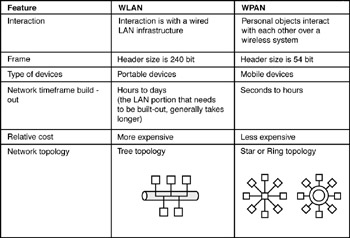Wireless Personal Area Networks (WPANs)
|
|
PAN refers to very small-area and low-power radio-transmission-based networking systems. Typically, these systems operate at 1 Mbps or below and have low power requirements; the distance is measured in feet (for example, 33 feet). Bluetooth technology is a prime example of this kind of technology; there are IEEE groups addressing the further standardization of the technology (the IEEE 802.15 committee is now working on an IEEE-level standard).
WPAN's Bluetooth wireless technology has received considerable media attention. Proponents position it as a de facto standard as well as a specification for small-form-factor, low-cost, short-range (LAN-level) radio links between mobile PCs, mobile phones, and other portable devices. The technology is just now becoming available. In support of WPANs, inexpensive PCMCIA cards are being developed that can fit in PCs and PDAs. Bluetooth chips that cost under $5 are also being targeted. Other equipment has the radio chip built in (especially in the case of telephone equipment). The ultimate goal is to incorporate these chips in virtually every kind of device: PDAs, mobile phones, computers, and desktop phones.[32] Figure 1-13 provides a comparison between WLANs and WPANs.[33]

Figure 1-13: WLAN versus WPAN
[32]www.wkmn.com/newsite/wireless.html.
[33]This figure is partially based on IBM materials by V. Malhotra, 'Checking on IEEE 802.15,' www-106.ibm/developerworks/library/wi-checking/?dwzone=wireless, September 2001.
|
|
EAN: N/A
Pages: 88
- Penultimate Hop Popping
- Cell-Mode MPLS over ATM Overview, Configuration, and Verification
- Case Study-Hub and Spoke MPLS VPN Network Using BGP PE-CE Routing for Sites Using Unique AS Numbers
- Case Study-Inter-AS Implementing Route-Reflector and BGP Confederation in Provider Networks
- Case Study 9: Implementing VPLS Services with the GSR 12000 Series